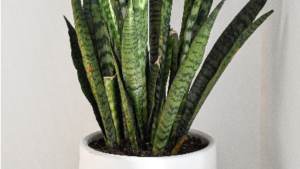For people living with asthma, the benefits of fresh air can’t be understated — especially when it comes to the home. Unfortunately, indoor air is often stale and dry and can contain pollutants that exacerbate asthma symptoms. Household cleaning products, HVAC systems, and electronics all pump chemical vapors into your home, causing the air quality to decrease.
Not only do houseplants look nice and are great for styling your interior spaces, but they also work hard at cleaning the air of everyday toxins and replacing lost humidity back into the atmosphere. In fact, house plants are so effective at increasing oxygen levels, NASA studied them in-depth to find how they could be utilized during space missions. After analyzing different kinds of indoor houseplants, NASA found that many had a unique way of naturally cleansing the air and removing toxins that are detrimental to our health.
Most people know that plants absorb carbon dioxide and release oxygen; however, they also behave as natural humidifiers by releasing moisture into the air and may be able to help purify the air. According to NASA’s 1989 study, several plants are most active at removing common indoor air pollutants such as ammonia, formaldehyde, trichloroethylene and benzene. High levels of these chemicals in the home can cause what is known as “sick building syndrome,” a collection of symptoms that include sore throat, breathing difficulties, a tight chest and runny nose, among others.
Promisingly, NASA’s study found that at least one plant per 100 square feet of space resulted in efficient air cleaning of indoor pollutants. It’s important to note that this study was conducted under sealed lab conditions, and additional research has shown mixed results in traditional indoor spaces.
Top 5 Asthma Friendly Houseplants
If you want to take advantage of some houseplant purifying power, it’s best that you add a few houseplants to the most occupied rooms in your home, such as the living room and bedroom. Here are five asthma-friendly houseplants to spruce up your living space.
Peace Lily

The Peace Lily is a beautiful evergreen plant that is great for people who don’t have a green thumb—because it’s difficult to kill! According to NASA’s analysis of houseplants, the Peace Lily did the best job at removing airborne Volatile Organic Compounds (VOCs)
Simply place this plant in a dark corner, as they require very little light, and water it once a week. But be aware, the Peace Lily’s leaves are mildly toxic to humans and animals in large quantities, so keep it out of reach of children and pets.
Snake Plant

The Snake Plant is an evergreen perennial plant that is good at absorbing airborne toxins, such as formaldehyde, nitrogen oxide, and benzene. In addition, they grow well inside and require very little maintenance.
This plant loves bright light, but can tolerate low-light areas for an extended period. Be sure not to over-water it, however, as it can rot quickly in moist soil. You should also keep this plant out of reach of pets, as it can be toxic when ingested.
English Ivy

English Ivy, or European Ivy, is an evergreen climbing vine that’s extremely popular for outdoor landscaping. Relatively easy to care for, English Ivy likes lots of sunlight and regular water.
It’s also effective at removing benzene, formaldehyde, xylene, and toluene from the air, according to NASA’s Clean Air Study. Further studies have also found that English Ivy reduces mold in the home.
Bamboo Palm

The bamboo palm is a slow-growing small palm that’s the perfect addition to stylish living areas. A natural humidifier, the bamboo palm helps to pump much-needed moisture into dry indoor atmospheres.
Bamboo palms like shady areas and occasional sun, making it an excellent houseplant to keep indoors.
Areca Palm

Areca Palm is a beautiful palm that can spruce up any interior space. It acts as a natural humidifier by releasing lots of moisture into the air—perfect if your asthma is exacerbated by dry air.
To take care of an Areca Palm, you should keep it in bright but indirect sunlight. They also like to be watered often so that their soil is lightly moist in spring and summer, and slightly drier during fall and winter.
The Bottom Line
If you or one of your family members has asthma, it’s essential to keep your indoor air free as free of allergens and toxins as possible. Although house plants may be able to increase the air quality in your home, it’s important not to solely rely on them to improve your asthma symptoms. Always discuss lifestyle changes with your healthcare provider, and continue to take your medication as prescribed.
Read more from NASA on this study.
